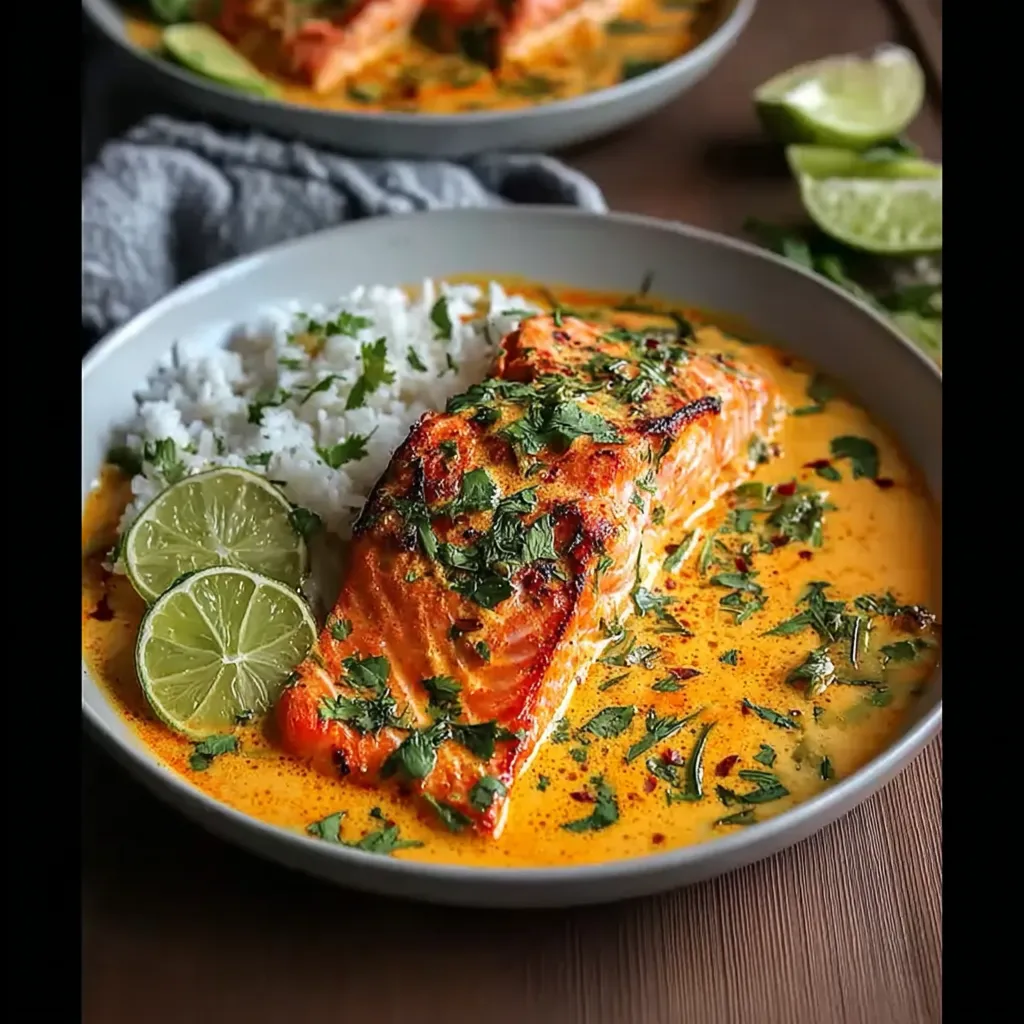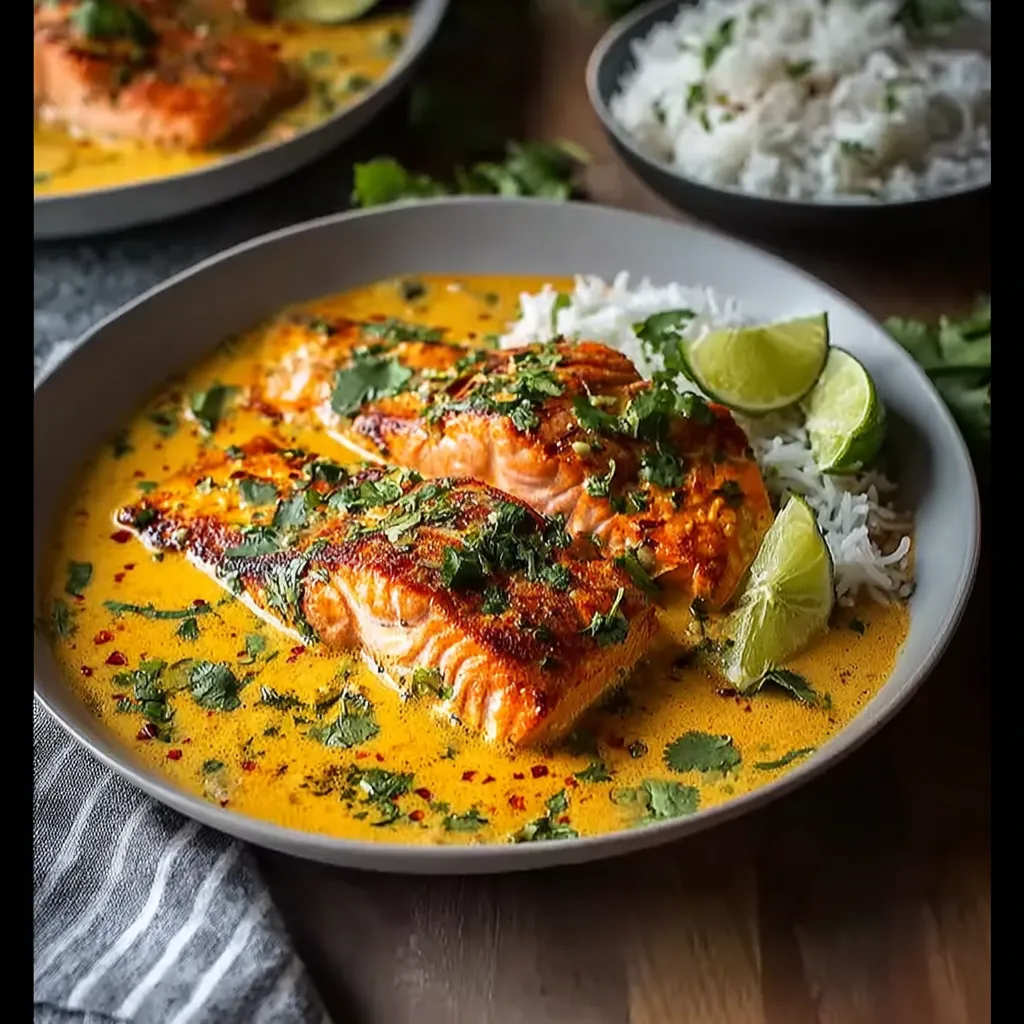 Bookmark
Bookmark
This coconut curry salmon has become my weeknight secret weapon when I want a restaurant-quality dinner without the fuss. The rich coconut milk creates a velvety sauce that perfectly complements the tender salmon, while the red curry paste adds just the right amount of warmth and complexity.
I first made this recipe when trying to impress my in laws during their first visit to our home. Now it has become their requested dish whenever they visit and they often ask me for the recipe to make at home.
Ingredients
- Salmon fillets choose wild caught when possible for the best flavor and nutrition
- Full fat coconut milk provides the creamy base for the sauce avoid light versions which will make a thinner sauce
- Red curry paste the heart of the flavor provides depth and complexity without overwhelming heat
- Butter divided between searing and the sauce adds richness
- Garlic minced fresh is always best for the most vibrant flavor
- Fresh lime juice brightens the entire dish and balances the richness
- Salt and pepper to taste always crucial for properly seasoning any dish
- Optional chili flakes add customizable heat for those who enjoy spice
- Fresh cilantro provides a fresh herbal note and beautiful garnish
Step-by-Step Instructions
- Prepare the Salmon
- Pat the salmon fillets completely dry with paper towels this is crucial for achieving a perfect sear. Season both sides generously with salt and pepper ensuring even coverage. Heat 1 tablespoon of butter in a large skillet over medium high heat until it begins to foam which indicates it has reached the perfect temperature for searing.
- Sear the Salmon
- Place the seasoned salmon fillets in the hot skillet skin side down pressing gently with a spatula to ensure full contact with the pan. Cook undisturbed for 3 4 minutes until the skin becomes crispy and golden. Carefully flip the fillets and cook for another 3 4 minutes until the salmon is mostly cooked through but still slightly translucent in the center. Remove from the pan and set aside on a warm plate.
- Make the Coconut Curry Sauce
- Using the same skillet with all its flavorful fond add the remaining butter and allow it to melt. Add the minced garlic and sauté for about 1 minute stirring constantly to prevent burning while releasing its aromatic oils. Add the red curry paste and use your spatula to work it into the butter and garlic cooking for 2 minutes which allows the spices to bloom and intensify.
- Develop the Sauce
- Pour in the coconut milk while stirring continuously to incorporate all the curry paste evenly. Reduce the heat to maintain a gentle simmer and let the sauce cook for 5 7 minutes watching as it gradually thickens and deepens in color. The sauce should coat the back of a spoon when ready. Finish with fresh lime juice and adjust seasoning with salt and pepper tasting as you go.
- Combine and Finish
- Return the seared salmon to the skillet placing it gently into the simmering sauce. Spoon some sauce over the top of each fillet and allow everything to simmer together for another 5 7 minutes. The salmon will finish cooking through while absorbing the curry flavors. For those who enjoy heat sprinkle with chili flakes in the final minutes of cooking.
 Bookmark
Bookmark
The red curry paste is truly the magical ingredient in this recipe. I spent years using storebought versions before learning to make my own on a cooking trip to Thailand. While homemade is wonderful a quality jarred version works beautifully and saves significant time without sacrificing flavor.
Perfectly Cooked Salmon Tips
The key to perfect salmon is not overcooking it. When the salmon flakes easily with a fork but still has a slightly translucent center it is perfectly done. It will continue cooking slightly when returned to the warm sauce so keep this in mind when determining doneness. Wild caught salmon tends to cook faster than farmed varieties due to its lower fat content so adjust your cooking time accordingly if changing between types.
Easy Substitutions
This recipe is wonderfully adaptable to what you have on hand. Green or yellow curry paste can replace the red for different flavor profiles. Coconut cream can substitute for coconut milk if you want an even richer sauce. For a dairy free version replace the butter with coconut oil or ghee. White fish like cod or halibut works beautifully in place of salmon though cooking times may need adjustment. Lime zest makes a perfect replacement if fresh limes are unavailable.
Serving Suggestions
This curry salmon pairs perfectly with jasmine rice or cauliflower rice for a lower carb option. The sauce is so delicious you will want something to soak it up. For a complete meal serve with steamed bok choy or broccoli on the side. A simple cucumber salad with rice vinegar dressing provides a refreshing contrast to the rich curry. For entertaining serve family style on a large platter garnished generously with fresh herbs and lime wedges for an impressive presentation that requires minimal effort.
Recipe FAQs
- → Can I use a different type of fish for this dish?
Yes! While salmon works beautifully with the coconut curry sauce, you can substitute other firm-fleshed fish like cod, halibut, or sea bass. Just adjust cooking times accordingly as thinner fillets will cook more quickly.
- → How can I make this dish spicier?
To increase the heat level, you can add more red curry paste, include the optional chili flakes, or add a finely chopped Thai chili pepper to the sauce. Start with small amounts and adjust to your preference.
- → What can I serve with coconut curry salmon?
This dish pairs wonderfully with jasmine rice, cauliflower rice, or rice noodles to soak up the delicious sauce. For a complete meal, add steamed vegetables like broccoli or bok choy on the side.
- → Can I make this dish dairy-free?
Yes, simply replace the butter with coconut oil or a plant-based butter alternative. The coconut milk already provides creaminess, so the flavor profile will remain similar.
- → How do I know when the salmon is fully cooked?
Salmon is done when it flakes easily with a fork and reaches an internal temperature of 145°F (63°C). The flesh should be opaque but still moist. Be careful not to overcook as salmon can quickly become dry.
- → Can I prepare any components of this dish ahead of time?
You can prepare the coconut curry sauce up to a day in advance and refrigerate it. When ready to serve, reheat the sauce gently and then cook the salmon fresh for the best texture and flavor.
